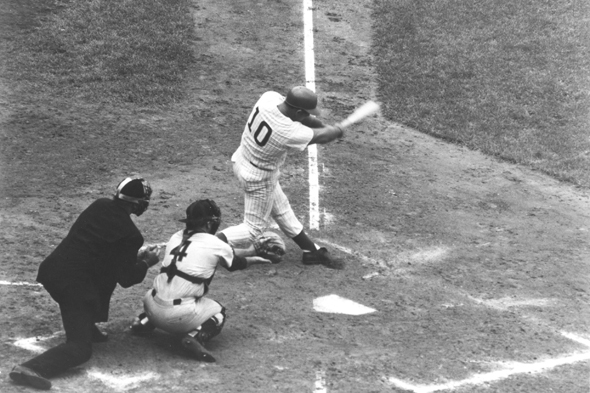
Former Chicago Cubs third baseman Ron Santo, a Seattle native who graduated from Franklin High School, once worked as a Sicks’ Stadium bat boy, and later waged a public battle with diabetes, has been elected to the baseball Hall of Fame by the Golden Era committee.
The Cooperstown, NY.-based Hall announced the voting results Monday at baseball’s winter meetings. The Golden Era committee selected Santo a year after he died Dec. 2, 2010, in Scottsdale, AZ., at 70.
During a career that spanned 1960-74, Santo made nine All-Star teams, hit 342 home runs and won five Gold Gloves. Following his playing days, Santo served as a Cubs broadcaster for two decades, eagerly rooting for his favorite team on the air.
Santo received 15 votes from the 16-member panel. Jim Kaat drew 10 votes, two short of the required number. Gil Hodges and Minnie Minoso each had nine votes. Santo was passed over by the previous Veterans committee in 2003, 2005 and 2008. After that committee, comprised of current Hall of Famers, failed to elect anyone for eight consecutive years, the Hall of Fame changed the election rules.
The Golden Era committee is comprised of 16 individuals, including Hall of Fame players, baseball executives and veteran baseball reporters.
Santo, who was enshrined in the State of Washington Sports Hall of Fame in 1983, played his entire career with the Cubs except for one season (1974) spent with the Chicago White Sox. He batted .300 or better four times and had his best statistical year in 1966, when he hit .312 with 30 home runs, 94 RBIs and a .412 on-base percentage, best in the National League. Santo also had a career-long 28-game hitting streak in 1966.
Santo hit a career-high 33 home runs and added a career-high 13 triples in 1964, tops in the National League. He led the National League in times on base in 1964 (273), 1966 (276) and 1967 (275).
Santo grew up in south Seattle, not far from Sicks’ Stadium, where he worked as an usher, in the press box, in the clubhouse and as a bat boy for a Rainiers team whose parent was the Cincinnati Reds. During his high school years at Franklin, he starred football, basketball and baseball.
Santo received a $20,000 signing bonus when he joined the Cubs in 1959. He entered the organization as a catcher, but eventually moved to third base. Santo’s rise through the organization took a year and three months. He excelled at San Antonio of the Texas League (AA) and Houston of the American Association (AAA).
Santo made his major league debut June 26, 1960, in a double header against the Pittsburgh Pirates. He had two hits and drove in three runs in the first game (off Pirates starter Bob Friend), and added a hit and two RBIs (off Vern Law) in the nightcap. He was in the big leagues to stay.
Making Santo’s accomplishments remarkable was a secret he held throughout most of his playing career — he was diagnosed in his teen years as a diabetic. Santo at first kept the matter out of the public eye, but later became a champion in the fight against the disease, raising millions of dollars for research.
When it became apparent that his celebrity could enhance awareness, Santo became a driving force, as well as an inspiration to others burdened with it.
Ultimately, the disease forced amputation of both legs just below the knees. Santo also had his bladder removed and had heart bypass surgery. Despite his medical issues, he continued to work in the Cubs’ radio booth, the 2010 season his 20th and last in that job. Bladder cancer finally claimed Santo (see Wayback Machine: Ron Santo).
Santo is the fifth individual with connections to the state to pass through the portals of Cooperstown. The others:
EARL AVERILL (1975): A Snohomish native, Averill spent 13 years in the major leagues (1929-41), mostly with Cleveland. He hit above .300 eight times and finished with a lifetime batting average of .318. Averill played in six All-Star games, including the inaugural in 1933 (see Wayback Machine: The Earl And Pearl Of Snohomish).
AMOS RUSIE (1977): Born in Moorsville, IN., Rusie spent the majority of his post-baseball life in Seattle, where he died Dec. 6, 1942. During his career (1889-1901), mainly with the New York Giants, Rusie won 246 games and posted 30+win seasons four consecutive years: 33 in 1891, 32 in 1892, 33 in 1893 and a career-high 36 in 1894. A fearsome presence on the mound (he led the National League in strikeouts five times), Rusie is the man most responsible for the rule that moved mound from 50 feet to 60 feet, 6 inches from home plate.
RYNE SANDBERG (2005): A Spokane native, Sandberg made 10 National League All-Star teams and won nine Gold Gloves during his career with the Chicago Cubs (1982-97). He had his best year in 1984 when he hit .314 and led the National League with 114 runs scored and 19 triples and earned the league’s Most Valuable Player award.
DAVE NIEHAUS (2008): Winner of the 2008 Ford Frick award for broadcasters, the popular Niehaus called Mariners games on radio and TV for more than 30 seasons before his death from a heart attack following the 2010 season. The Mariners unveiled a statue of Niehaus at Safeco Field in September (see A Fitting Tribute To Icon Dave Niehaus).

1 Comment
@notaboomer – you’re right – your’re way off topic. A little insecure i guess- you’re right – a bunch of sissy-ass pansies who always fake injuries can’t hold a candle to professionals playing real sports…